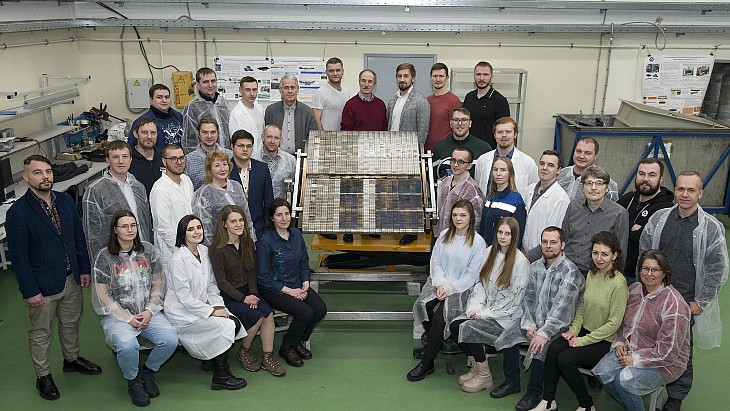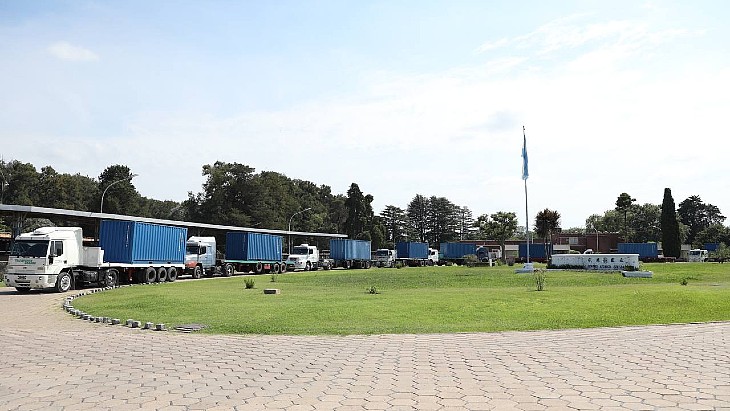FUSION FUN SCI-FI-TEK 70YRS IN DEVELOPMENT
Russia completes tests on first wall panels for ITER
11 January 2024
Manufacturing and testing of prototype first wall panels for the International Thermonuclear Experimental Reactor (ITER) fusion machine has been successfully completed, says St Petersburg-based JSC NIIEFA - part of the Russian state nuclear corporation Rosatom.
 (Image: Rosatom)
(Image: Rosatom)
The last stage of the multi-year process - from exploratory experiments on small mock-ups to manufacturing and acceptance tests on a full-scale prototype of a highly loaded panel of the first wall of the vacuum chamber of ITER - was measuring the geometric parameters of the prototype after tests.
For the ITER project, which is under construction in Cadarache in southern France, Russia's responsibilities include manufacturing 179 of the most energy intensive (up to 5 MW per square metre) panels of the first wall, which is 40% of the total area of the reactor wall.
Rustam Enikeev, deputy director general for thermonuclear and magnetic technologies at JSC NIIEFA, said: "The next step will be to obtain permission to begin mass production, this will require the preparation and approval of a large volume of documents."
ITER is a major international project to build a tokamak fusion device designed to prove the feasibility of fusion as a large-scale and carbon-free source of energy. The goal of ITER is to operate at 500 MW (for at least 400 seconds continuously) with 50 MW of plasma heating power input. It appears that an additional 300 MW of electricity input may be required in operation. No electricity will be generated at ITER.
Thirty-three nations are currently collaborating to build ITER - the European Union is contributing almost half of the cost of its construction, while the other six members (China, India, Japan, South Korea, Russia and the USA) are contributing equally to the rest. Construction began in 2010. The UK was also involved but in the wake of its departure from the EU it announced in September it was leaving Euroatom. Existing contracts are being honoured but ITER says the UK will not be part of new contracts. Switzerland is currently considered to be a "non-participating third country" as its negotiations with Euratom on an association agreement continues.
According to the ITER website, the first wall panels "are the detachable, front-facing elements of the blanket that are designed to withstand the heat flux from the plasma. These highly technological components are made of beryllium tiles bonded with a copper alloy and 316L (N) stainless steel".
Rosatom says that each panel consists of 40 so-called fingers and the overall dimensions of one panel are 2 metres by 1.5 metres by 0.5 metres, with a weight of about 800 kg. They can be in different shapes, with scientists at JSC NIIEFA developing about 40 design options. It added that NIIEFA specialists "gained unique experience and competencies in the development of the design of plasm-facing components" and the experience would benefit "future national projects in the field of development and creation of plasma-facing components for controlled thermonuclear fusion installations".
Russian record for pulse duration in a tokamak
Meanwhile scientists at the Kurchatov Institute have achieved a discharge with a plasma current of 260 kiloamperes (kA) lasting more than two seconds, a new duration record for tokamaks in Russia.
The institute said that temperatures in the plasma in the T-15MD tokamak hit 40 million degrees Celsius during the experiment, which took place on 15 December.
Researched and written by World Nuclear News
Eight truck convoy delivers giant German SANS to Argentina's Neutron Beam Laboratory
12 January 2024
The small-angle neutron scattering instrument (SANS) is 33 metres long when assembled and has been donated by the German Helmholtz Zentrum Berlin institute following the closure of the BER-II reactor in 2019. It will be reassembled and come into operation when Argentina's RA-10 multipurpose research reactor begins operating.
 (Image: CNEA)
(Image: CNEA)The instrument is used to analyse structures between 0.5 and 400 nanometers (a nanometre is one billionth of a metre) allowing materials science studies, polymers, soft matter, electrochemistry, magnetic systems and biological samples, among others, at the nanoscale.
Karina Pierpauli, executive director of the Argentine Neutron Beam Laboratory, called the arrival a "milestone" and a result of "scientific-technological cooperation between Argentina and Germany" over recent years.
According to Argentina's National Atomic Energy Commission (CNEA), the instrument has a collimation and detection system that can provide various experimental configurations and the detection tube, which operates in high vacuum, is 16 metres long and 1.5 metres in diameter.
CNEA said that Argentina was selected from a number of countries who applied to host the instrument at the end of its life-cycle at BER-II, and will give it new life using the neutron beams that the RA-10 reactor, scheduled for 2025, will produce.
The instrument was carefully taken apart in Germany during 2021 and 2022, with each step documented so it can be reassembled in the beam laboratory being built next to RA-10 at the Ezeiza Atomic Centre in Argentina. Cold assembly is due to be carried out this year.
The size of the equipment meant that eight containers were used to transport it by ship from Hamburg before it was transported by a fleet of lorries to its new home. A ninth container with irradiated components, has specialised transport and is due to arrive next month.
In July, CNEA said the RA-10 - a 30 MWt open-pool research reactor - was about 80% completed, with expectations it would be operating in 2025 and would replace the RA-3 reactor on the same site. This 10 MWt pool-type reactor began operations in 1967. The RA-10 will be used for the production of medical radioisotopes and CNEA said the Argentine Neutron Beam Laboratory was "aimed at exploiting the neutron beams that originate in the reactor core for science and technology ... in addition, there will be a materials testing laboratory to study their behaviour under irradiation. This includes fuel element rods and plates, but also structural materials intended for fourth-generation nuclear reactors."
No comments:
Post a Comment